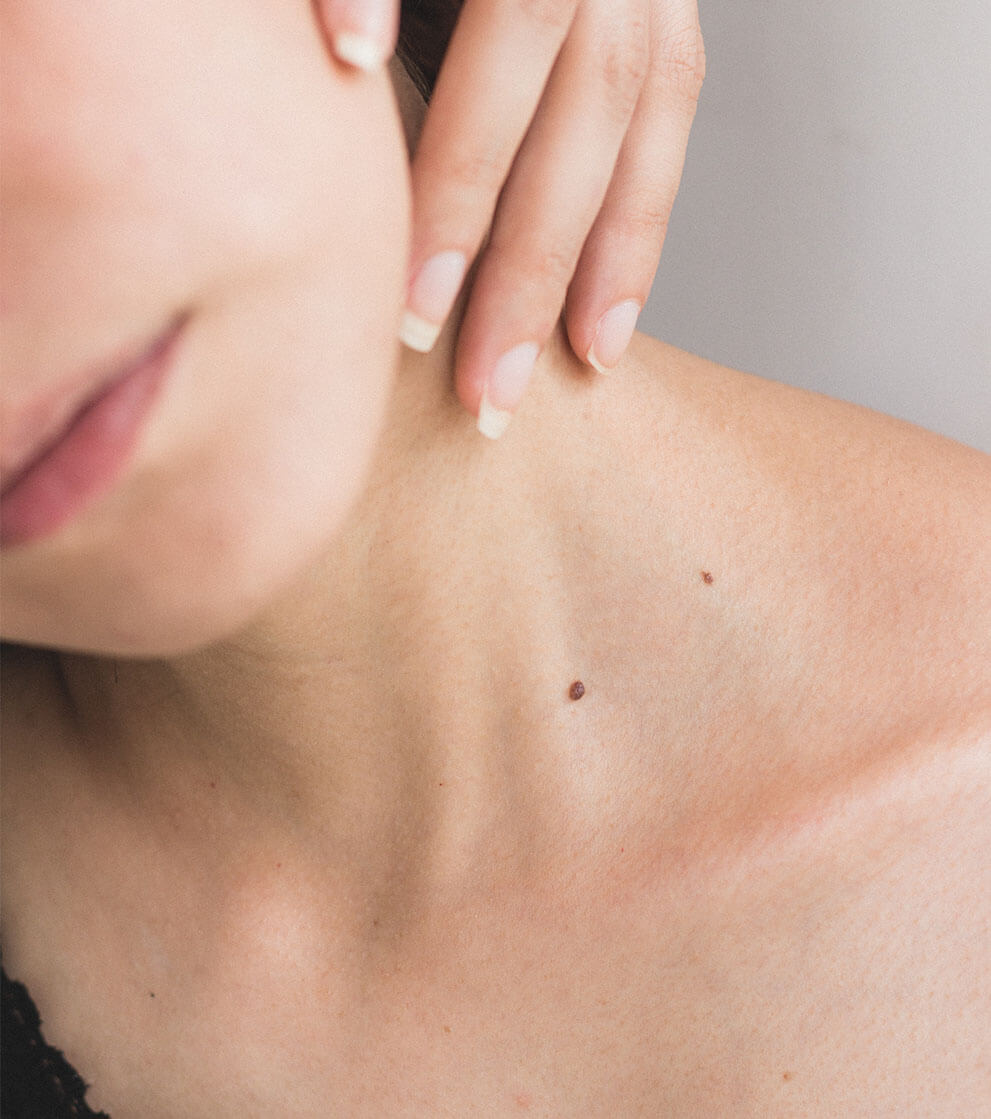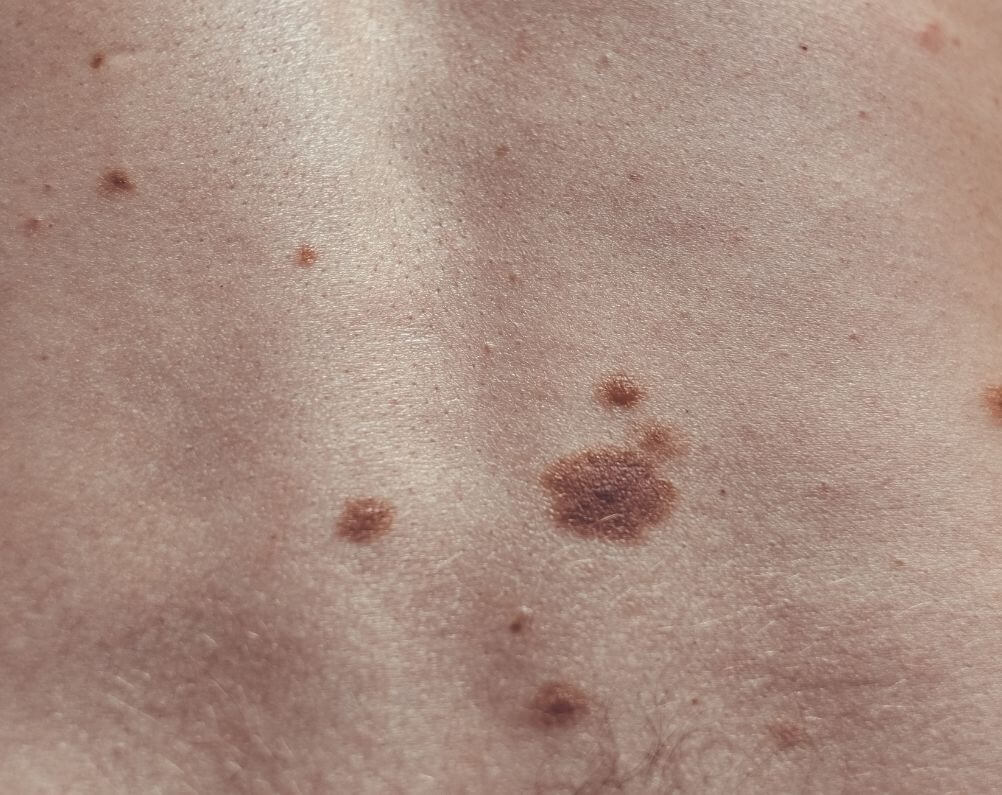LENTIGO MALIGNA & MELANOMA SITU TREATMENTS IN NORTHWOOD & HARLEY STREET
These are the very earliest stages of skin cancer called melanoma. The word ‘melanoma’ comes from the Greek word ‘melas’, meaning black. Melanin is the dark pigment that gives the skin its natural colour. Melanin is made in the skin by pigment cells called melanocytes. After our skin is exposed to sunlight, the melanocytes make more melanin, and so the skin becomes darker. Melanocytes sometimes grow together in harmless groups or clusters, which are known as moles. Most people have between 10 and 50 moles and often they are darker than the surrounding skin.
Melanomas can arise in or near to a mole, but can also appear on skin that looks quite normal. They develop when the skin pigment cells (melanocytes) become cancerous and multiply in an uncontrolled way. They can then invade the skin around them and may also spread to other areas such as the lymph nodes, liver and lungs.
‘In situ’ means that the cancer cells have not had the opportunity to spread to anywhere else in the body. There are cancer cells in the top layer of the skin (the epidermis) but they are all contained in the area in which they began to develop. They have not started to spread or grow into deeper layers of the skin and have not become invasive. This is why some doctors call in situ cancers ‘pre cancer’. The prognosis is excellent.
Lentigo maligna is a type of melanoma in situ. It is a slow growing lesion that appears in areas of skin that get a lot of sun exposure, such as the face or upper body. Because it grows slowly it can take years to develop. Similar to melanoma in situ, lentigo maligna has not spread and is only in the top layer of skin.
Both melanoma in situ and lentigo maligna are cured with surgery. However if not treated with appropriate surgery, they can develop into an invasive cancer. This is why it is important to have them removed with an adequate surgical margin and to know about preventative measures you can take which will lower your risk of these conditions occurring again in the future.
Book ConsultationWhat do Lentigo Maligna and Melanoma Situ look like?
All melanomas do not look the same, and there are several different types. The ABCDE system (below) tells you some of the things to look out for.
A melanoma may show one or more of the following features:
Asymmetry– the two halves of the area differ in their shape.
Border– the edges of the area may be irregular or blurred, and sometimes show notches.
Colour– this may be uneven. Different shades of black, brown and pink may be seen.
Diameter– most melanomas are at least 6 mm. in diameter.
Evolution– rapid change in a pre-existing mole.
Melanomas can appear on any part of the skin but they are most common in men on the body, and in women on the legs. Lentigo maligna is common in areas of skin that get a lot of sun exposure, such as the face or upper body.

Your Consultation
At the Cedars Dermatology Clinic in Northwood & Harley Street, we draw deeply from the consultation process. Our expert clinicians will listen carefully to understand your skin concerns and aesthetic and medical goals.
- Your medical history is taken into account
- We thoroughly assess your skin
- We listen well to understand your concerns and goals
- We draw up a personalised treatment plan
FAQs about Lentigo Maligna & Melanoma Situ
The most important preventable cause is exposure to too much ultraviolet light in sunlight, especially during the first 20 years of life. They are especially common in white-skinned people who live in sunny countries. The use of artificial sources of ultraviolet light, such as sun beds, also raises the risk of getting a melanoma.
Some people are more likely to get a melanoma than others:
- About 7,000 people in the UK get diagnosed with melanoma each year. It is more common in women than men. It is a very rare cancer in children, but it is the second most common cancer in people aged 15 to 34.
- The risk is increased if another family member has had a melanoma.
- People who have already had one melanoma are at an increased risk of getting another one.
- Some people have many unusual (atypical) moles. They tend to be larger than ordinary moles, to be present in large numbers, and to have irregular edges or colour patterns. The tendency to have these moles can run in families and carries an increased risk of getting a melanoma.
- People who burn easily in the sun are particularly at risk. They occur most often in fair-skinned people who tan poorly. Often they have blond or red hair, blue or green eyes, and freckle easily. They are less common in dark-skinned people.
- Past episodes of severe sunburn, often with blisters, and particularly in childhood, increase the risk of developing them. However, not all of them are due to sun exposure, and some appear in areas that are normally kept covered.
- People with many (more than 50) ordinary moles, or with a very large dark hairy birthmark, have a slightly higher than average chance of developing a melanoma.
- People with a damaged immune system (e.g. as a result of an HIV infection or taking immunosuppressive drugs, perhaps after an organ transplant) have an increased chance of getting a melanoma.
About 1 in 10 of people with a melanoma has family members who have also had one. There are several reasons for this. Fair skin is inherited, while atypical moles and a tendency to have large numbers of ordinary moles also run in families.
Lentigo maligna may appear as a long-standing discoloured patch, most commonly on the face, which slowly enlarges and develops darker areas. Many melanomas start as minor changes in the size, shape or colour of an existing mole (see below); others begin as a dark area that can look like a new mole. Most in situ (very early) melanomas do not cause any symptoms, but tingling or itching may occur. If a lentigo maligna or an in situ melanoma is not treated early, later it could become hard and lumpy, and bleed, ooze or crust.
If you are at all worried about changes in a mole, or about a new area of pigmentation appearing on your skin, you should see your family doctor. The ABCDE changes listed above can sometimes be found in completely harmless conditions, and your doctor may be able to put your mind at rest. However, if there is still any doubt, your doctor will usually refer you to a specialist (a dermatologist or a surgeon with a special interest in pigmented lesions) who will examine the area and decide whether it needs to be removed.
If the mole needs to be examined under a microscope, the whole of the suspicious area will then be removed under a local anaesthetic (a procedure known as excision) and sent to the laboratory to be examined. If the area is too large to remove easily, a sample of it (an incisional biopsy) will be taken. If a melanoma is found, the pathology report will provide valuable information that will help to plan the next step in treatment.
Yes, the outlook for Lentigo Maligna and Melanoma Situ is excellent. It is very rare for them to come back because they were ‘in situ’, therefore they will not have had an opportunity to spread elsewhere in the body.
At present, the treatment for Lentigo Maligna and Melanoma Situ is surgical. There is no other treatment of proven benefit, and usually no other tests are needed. Most people who have had a lentigo maligna, or melanoma in situ, removed will need another operation to try to prevent the melanoma from coming back at the original site. During the operation, some healthy skin will be removed from around the original scar to make absolutely sure that all of the melanoma has been taken away, and this makes the scar larger than before. Occasionally a skin graft will be needed.
The British Association of Dermatologists and other health organisations such as NICE (National Institute for Health and Clinical Excellence) state that people who have had a Lentigo Maligna and Melanoma Situ do not need any follow up visits with their specialist. This is because in situ melanomas are very unlikely to come back once the area has been removed. Due to the excellent prognosis of Lentigo Maligna and Melanoma Situ, you will usually be seen once again in clinic and then discharged.
Once your melanoma has been treated, you should be able to get back to a normal lifestyle quite quickly. You should also take a few sensible precautions to stop yourself getting another one, as below.
- You should look at all areas of your skin monthly for moles that are growing, or changing in the ways listed in the ABCDE rules (see above). If you find any worrying changes, contact your doctor immediately.
- You must also protect yourself from too much sun. This means that you need to be careful to avoid sunbathing, sunburn and tanning. You can do this by covering yourself up and using sun protection creams, especially if on holiday in a hot country (see the ‘top sun safety tips’ below for more information).
- Do not use sun beds and tanning lamps.
- Share sun advice and other information with blood relatives as they also may be at increased risk of getting a melanoma. In particular, protect your children from the sun, as exposure during childhood seems to be particularly damaging.
Having had a melanoma does have some practical disadvantages. It can be difficult to obtain life or health insurance, particularly for the first five years after your diagnosis. It can also be difficult to obtain a mortgage. However, some insurance companies will be flexible so long as it is confirmed to them that you only had a lentigo maligna or a melanoma in situ that wasnot invasive and was completely excised.
Top sun safety tips
- Protect your skin with clothing, and don’t forget to wear a hat that protects your face, neck and ears, and a pair of UV protective sunglasses.
- Spend time in the shade between 11am and 3pm when it’s sunny. Step out of the sun before your skin has a chance to redden or burn. Keep babies and young children out of direct sunlight.
- When choosing a sunscreen look for a high protection SPF (SPF 30 or more) to protect against UVB, and the UVA circle logo and/or 4 or 5 UVA stars to protect against UVA. Apply plenty of sunscreen 15 to 30 minutes before going out in the sun, and reapply every two hours and straight after swimming and towel-drying.
- Keep babies and young children out of direct sunlight.
- The British Association of Dermatologists recommends that you tell your doctor about any changes to a mole or patch of skin. If your GP is concerned about your skin, make sure you see a Consultant Dermatologist – an expert in diagnosing skin cancer. Your doctor can refer you for free through the NHS.
- Sunscreens should not be used as an alternative to clothing and shade, rather they offer additional protection. No sunscreen will provide 100% protection.
- It may be worth taking Vitamin D supplement tablets (available from health food stores) as strictly avoiding sunlight can reduce Vitamin D levels.
Vitamin D advice
The evidence relating to the health effects of serum Vitamin D levels, sunlight exposure and Vitamin D intake remains inconclusive. Avoiding all sunlight exposure if you suffer from light sensitivity, or to reduce the risk of melanoma and other skin cancers, may be associated with Vitamin D deficiency.
Individuals avoiding all sun exposure should consider having their serum Vitamin D measured. If levels are reduced or deficient they may wish to consider taking supplementary vitamin D3, 10-25 micrograms per day, and increasing their intake of foods high in Vitamin D such as oily fish, eggs, meat, fortified margarines and cereals. Vitamin D3 supplements are widely available from health food shops.
Other treatments







